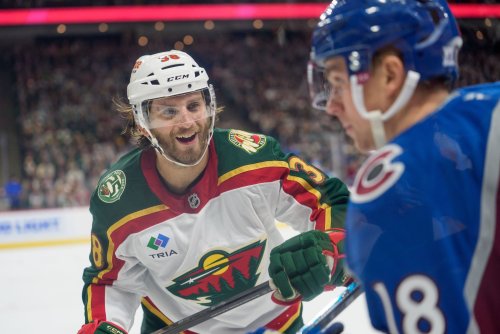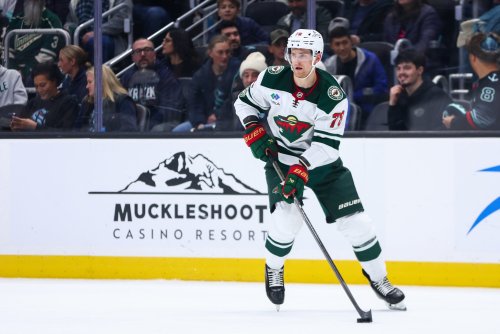
Last week, we took a deep dive into the payroll distribution of the top contending teams in the NHL this season. We were able to establish a few trends, specifically the correlation of average age to points earned, an ideal mix of youth to veterans, and an ideal percentage of salary to be applied to defense. Today, we continue to explore the numbers, but change our perspective from this season's contenders to winners over the past 5 years. When trying to discover a secret formula for winning, it makes the most sense to look at winners, no? That's what we're about to do here, and then we will look to see if what we learn from the last five years applies to what we've learned about this season.
Research Basis
Personnel Breakdown
This chart represents an age-based review of the rosters, providing overall numbers as well as a positional breakdown of the team's veteran versus youth presence. Goaltenders are not broken down simply because most NHL goalies are 26 and above as it takes longer for those players to develop. The numbers in each column of this graph represent the percentage of the position occupied by youth or veterans.
Take Aways
There is a lot of variation on several key topics here, the only thing that seems to be consistent is the total amount of spending increases as time moves forward and the salary cap increases. The range of %Youth vs % Vet has a pretty wide spread, going from 25% Youth to 40% Youth. There is also a huge variation in one of the items we found a strong correlation amongst our current year contenders, which is the percentage of the roster occupied by veteran defenders. We will see how that graphs out below.
Salary Breakdown
This chart represents a salary-based view of the rosters, again providing overall numbers by position but also further breaking down the position between veterans and youth. Goaltenders are included in overall numbers, but again are not broken down by age for the reasons mentioned above. The numbers in the columns of this graph represent the percentage of the team's total payroll against the designated category.
Take Aways
There is definitely more consistency when it comes to the salary spending of the past 5 Cup winners. However, we have to keep in mind that there are two teams that have repeat wins and by nature have many of the same players on the same contracts, so this isn't perfect data to create a model. It will still give us a pretty deep look at the strategy employed by those teams, which obviously paid off. The salary distribution by position remains the most interesting detail to look at, and you are seeing two teams with opposing strategies being successful. Remember, there are 360 minutes logged in a regulation game (60 min each x 3 forwards, 2 defense, 1 goalie). Forwards receive half (50%) of the minutes, defense receives one-third (33.3%) of the minutes and the goalie gets one-sixth (16.7%) of the total minutes played.
The Blackhawks have overspent expectations on their defensive corps in both years that they won. Conversely, the Kings have far overspent expectations on their forwards in their championship campaigns, but both strategies have led to engraving their names on Lord Stanley's cup. Boston did so by meeting in the middle and contributing a salary distribution which the average numbers point to. Either way, it appears that the general math to a competitive team lies with spending 60% of payroll on forwards, 30% on defense, 10% on goaltenders, which is consistent with what we are seeing with contenders in the current season. It also adds to the narrative that goaltenders are underpaid in the modern NHL, especially when they are considered the most important player on the ice.
Putting It All Together
To further understand what all of this means, we look for correlation between some the numbers presented to try to see what leads to a winning formula. The stronger a number correlates to earning points, the easier it will be to determine a trend, or in essence, reveal a truth about how age and spending drive points in the league.
Above, The X-axis (horizontal) represents Championship year, the Y-axis (vertical) represents average age of the team and the bubble size indicates the percentage of the team's payroll spent on youth. While the winners were once trending down in age, that trend has turned around and now it appears to be moving back up. Last year's Blackhawks club was a serious outlier with a couple of very grizzled veterans added to the top of an aging core of players. This could indicate a couple of things, the most common assumption would be that there are a core group of players on these teams that are staying with the team and aging as the years pass, but are still churning out playoff victories. The teams could be offsetting retiring players with youth, but the aging core sets the bar. It absolutely points out that somewhere between 25 and 26 appears to be a sweet spot, especially when you remove the outlier.
This graph represents championship year on the X-axis, % of total roster youth on the Y-axis and average age in the bubble size. We can definitely see a theme emerging here, even though there are outliers, the average converges at 32.7% of the roster occupied by youth players, which appears to consistently be where championship teams have aimed and where they should aim going forward. Based on this data, any team that isn't constructed this way might be missing something. This same concept looks to have held up over several years, and it would be interesting to take a look into the future to see how this year's incredibly strong draft class might change that in the coming years.
This graph represents Championship year on the X-axis, % Salary spend on Defense on the Y-axis and % Salary spent on goaltenders in the bubble size. This follows what we saw when we looked at this season's contending teams in that there was definitely some parity to the percentage of payroll spend on defense amongst championship teams. This was the same with current contenders, but this graph doesn't really show much convergence, hinting that there may be little correlation between winning and the percentage of payroll distribution, detracting from the notion that there is a perfect mix to be had.
The final graph depicts Championship year on the X, % Veteran D on the Y and % Vet D Salary in the bubble size. We've included it to compare against the same exact graph for contenders, which appeared to reveal a convergence point near 60% that correlated strongly to earning points during the current season. This data appears to refute that concept, as its convergence point is near 70%, which ultimately suggests that more work needs to be done to tie the presence of Veteran defenders to winning.
Conclusion
We've been able to tie a couple of numbers to predicting success for winning a Stanley Cup and refute some other concepts that seemed like an obvious answer to the question. There are definitely blueprints for winning based on the average age of players on a team as well as what portion of the roster is occupied by youth players. The first two graphs depict the consistency amongst winning clubs of those numbers. We've also learned that the percent of payroll distribution between forwards, defenders and goalie has less to do with determining the outcome of a season than logic might have you believe. We've also gotten rid of the notion that the percent of Veteran defenders is the secret sauce to precipitate winning. There are likely many more truths to be discovered by further investigation of the numbers, so here is a copy of the spreadsheet for you to download and take a look at on your own. Please leave anything you determine in your review in the comments section.
What Should the Wild Do?
Think you could write a story like this? Hockey Wilderness wants you to develop your voice, find an audience, and we'll pay you to do it. Just fill out this form.









Recommended Comments
There are no comments to display.
Join the conversation
You can post now and register later. If you have an account, sign in now to post with your account.
Note: Your post will require moderator approval before it will be visible.